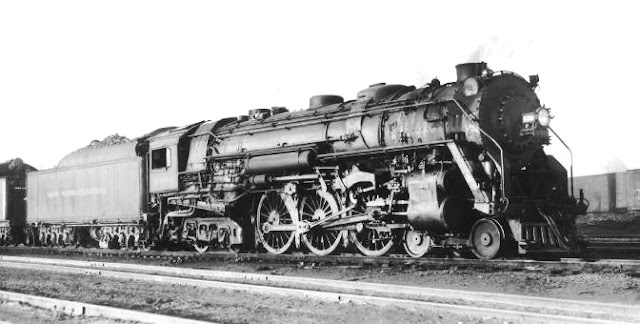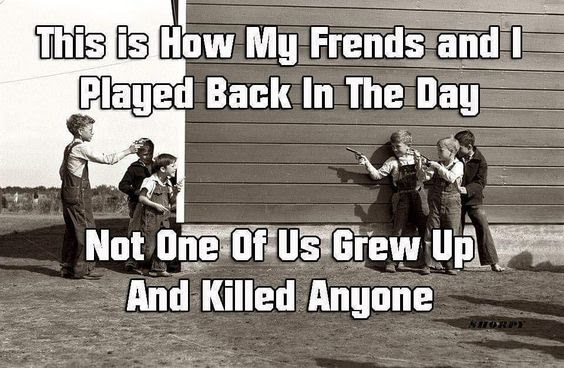The New York Central Hudsons
were a series of 275 4-6-4 "Hudson" type steam locomotives built in
several batches by the American Locomotive Company and the Lima
Locomotive Works between 1927 and 1938.
The Hudson came into being because the existing 4-6-2 Pacific power
was not able to keep up with the demands of longer, heavier trains and
higher speeds. The existing 4-6-2 design was modified with a bigger
boiler and firebox, and a modified Berkshire-type trailing truck,
creating a revolutionary class of locomotive that inspired other
railroads to build their own 'Hudsons'. Indeed, the Milwaukee Road was
the first to design its 4-6-4's - known at first as the 'Milwaukee' type
in the planning stages, but later known as the 'Baltic' type - but not
the first to be built as the Milwaukee was still short on money. These
engines are named after a river that was 315-miles long and flows from
north to south primarily through eastern New York in the United States -
the Hudson River. Locomotive No. 5200 was the very first Hudson built
for the New York Central and took to the rails in 1927.
These engines are used for high-speed passenger train work, the Hudson locomotives were famously known for hauling the New York Central's crack passenger trains, such as the 20th Century Limited and the Empire State Express. When these services were being re-equipped, the train engines had to be given some changes. In Autumn 1941, two Hudsons - 5426 and 5429 - were streamlined by Dreyfuss specially for the Empire State Express, and were painted black but mostly clad in silver. The newly-streamlined train was launched, rather soberingly, on the same day the Japanese bombed Pearl Harbor - December the 7th, 1941. Soon afterwards, the US declared war on Japan, and joined World War Two.
In 1944, NYC received permission from the War Production Board to build a new, high-speed locomotive of the 4-8-4 type, combining all the advantages of the Hudson with those of the Mohawk.
All the Hudsons were retired by the late 1950's with the onset of diesel locomotives in the mid-20th century.
No Hudsons have been preserved, though an engine of the same wheel arrangement with a look similar to that of the NYC Hudsons - Nickel Plate Road No. 170 - survives.
These engines are used for high-speed passenger train work, the Hudson locomotives were famously known for hauling the New York Central's crack passenger trains, such as the 20th Century Limited and the Empire State Express. When these services were being re-equipped, the train engines had to be given some changes. In Autumn 1941, two Hudsons - 5426 and 5429 - were streamlined by Dreyfuss specially for the Empire State Express, and were painted black but mostly clad in silver. The newly-streamlined train was launched, rather soberingly, on the same day the Japanese bombed Pearl Harbor - December the 7th, 1941. Soon afterwards, the US declared war on Japan, and joined World War Two.
In 1944, NYC received permission from the War Production Board to build a new, high-speed locomotive of the 4-8-4 type, combining all the advantages of the Hudson with those of the Mohawk.
All the Hudsons were retired by the late 1950's with the onset of diesel locomotives in the mid-20th century.
No Hudsons have been preserved, though an engine of the same wheel arrangement with a look similar to that of the NYC Hudsons - Nickel Plate Road No. 170 - survives.
Trivia
- There are 3 different Hudson classes: J-1, J-2 (for the Boston and Albany) and J-3. There are also 5 different sub-classes for the J-1 series: J-1a, J-1b, J-1c, J-1d, And J-1e.
- The Dreyfuss 'Century' Hudsons featured the nose of the smoke box that looked like a spaceship with the fin on it.
- Locomotive #5344 had streamlining briefly applied and named "Commodore Vanderbilt". The Commodore Vanderbilt was among the first streamlined steamers on the New York Central, if not the world. The streamlining was later replaced to match the last ten J-3a locomotives that had been built with streamlining designed by Henry Dreyfuss.
- The character Connor from Thomas & Friends is stylized after a streamlined NYC Dreyfuss Hudson, first introduced in the 2013 special King of the Railway.
- The Hudsons were featured in the 2006 computer-animated film Everyone's Hero.
- A J-1d Hudson was once originally numbered 6615 and it was later renumbered 5390. It was built for the Big Four Railway, hence its original number.
- However, since the Peppercorn A1 60163 Tornado was completed in the UK in 2008, some volunteers known as The Hudson Steam Locomotive Revival Project (HPR) are seeking to build a fully operable replica of a New York Central J-3a Hudson to be numbered 5475 in Buffalo, New York.
- A New York Central J3 class 'Hudson' locomotive was featured in The Iron Giant while wearing the paint scheme that the Norfolk And Western No. 611 wears.
- Two J-1 class Hudsons, numbers 5311 and 5313, were sold to the Toronto, Hamilton and Buffalo Railway in 1948 and were renumbered 501 and 502 respectively. They were retired and scrapped in 1954.
- Although all of the Hudsons were sold for scrap The tender from the 502 (formerly the 5313) was retained by the TH&B and converted to a steam generator car for use on passenger trains. The generator car still survives today and is part of the Steamtown National Historic Site collection. It is the largest extant single piece of a NYC Hudson.




































































